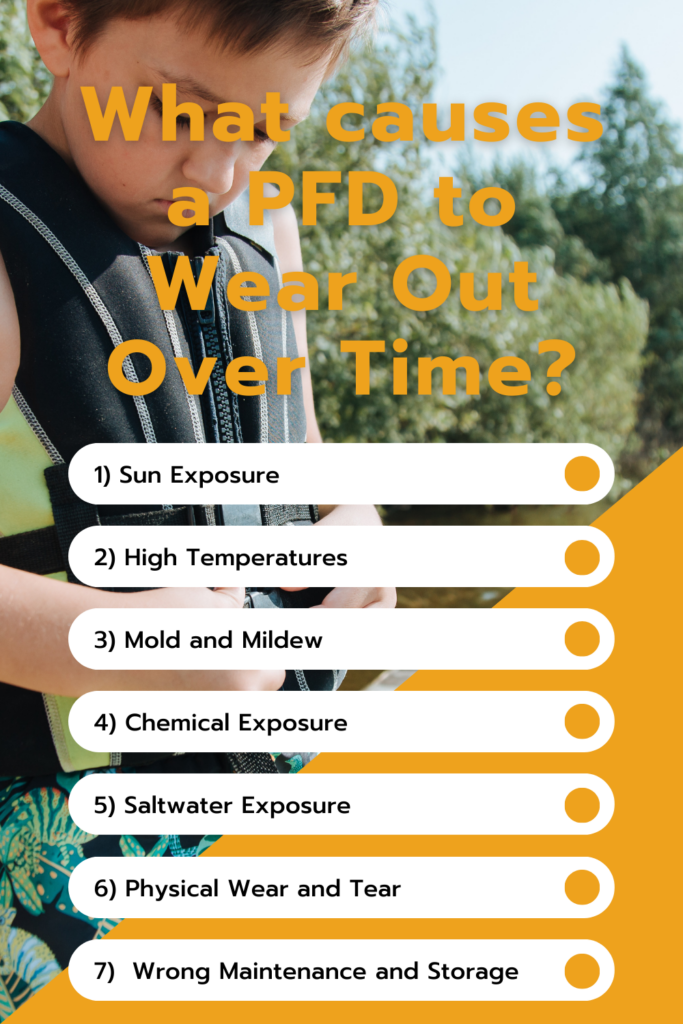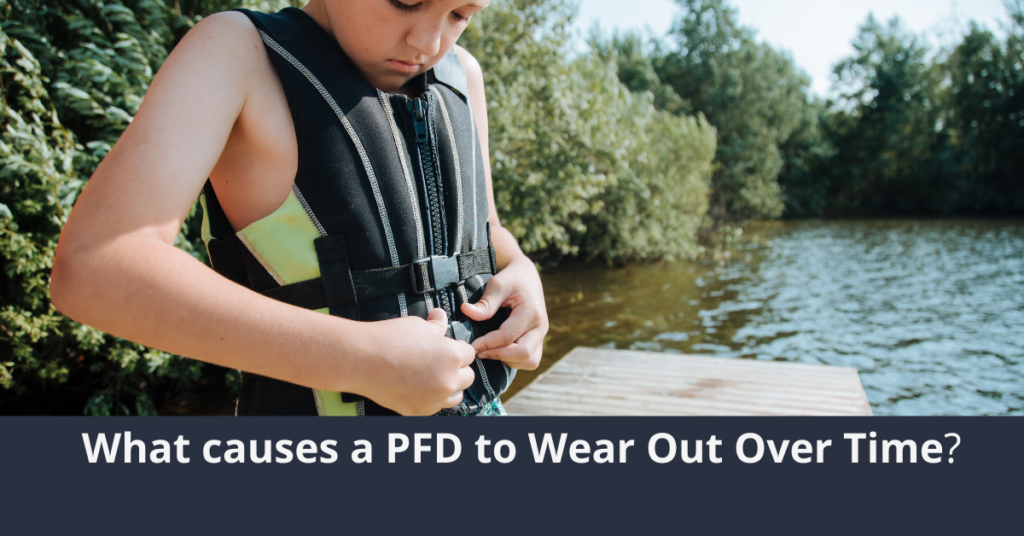Personal flotation devices, also known as PFDs, are an essential tool for any water-based activity. The primary role of these devices is to keep the user afloat in case of an emergency. However, PFDs are not designed to last forever. Over time, exposure to the elements and wrong usage or maintenance practices can cause PFDs to wear out. In this article, we will explore the various causes of PFD wear and tear over time, as well as how to prevent it.
Everything you will learn here
What causes a PFD to Wear Out Over Time?
What causes a PFD to Wear Out Over Time? — These 7 factors cause a PFD to wear out over time: Sun Exposure, High Temperatures, Mold and Mildew, Chemical Exposure, Saltwater Exposure, Physical Wear and Tear, Wrong Maintenance and Storage.
#1 Sun Exposure

Exposure to the sun’s rays is the most common wear and tear on PFDs. The suns UV rays can cause major wear and tear on a personal flotation device (PFD). This can include fading of the material and weakening of the fabric. The sun’s UV rays can also cause the PFD to become brittle and break down over time.
To protect a PFD from the sun, it is recommended to store it in a cool, dry place and cover it with a breathable fabric when not in use.
Moreover, it may prove advantageous to employ a UV-protector spray in the event that your Personal Flotation Device is subjected to prolonged exposure to direct sunlight.
- Spray on to outdoor gear made of plastic, vinyl, or neoprene to protect it from UV damage and sun deterioration
- Condition and enhance the color of rubber, nylon, and fiberglass; also prevents cracking and fading of fabrics
- Use this 4 fl oz multipurpose protectant on all gear that’s exposed to sunlight including kayaks, float tubes, waders and awnings
#2 High Temperatures
The extreme temperatures of the environment can have an adverse affect on a Personal Flotation Device (PFD). PFDs are not designed to withstand extremely high temperatures, as prolonged exposure to these temperatures can cause the material to become brittle and break down.
Once again: It is important to keep a PFD away from direct sunlight as much as possible and store it in a cool, dry place when not in use. Also do not put your PFD above or next to radiators or other heat sources.
Additionally, it is recommended to inspect the PFD periodically for signs of wear and tear. If any signs of heat damage are found, the PFD should be replaced immediately.
#3 Mold and Mildew
Mold and mildew can accumulate on a PFD over time, leading to wear and tear. Mold and mildew thrive in wet and damp environments, so it is important to keep a PFD dry at all times.
If the PFD is going to be stored for a period of time, make sure to rinse off the PFD with clear water and dry it completely.
Regularly inspecting the PFD for any mold or mildew is also key to avoiding major damage. If mold or mildew is found, the PFD should be cleaned and dried immediately. Store your PFD only in places with good air circulation.
#4 Chemicals
The materials of a PFD can be damaged by chemical exposure. Don’t use strong chemical cleaners or bleach. Mild soap will do the job just fine!
Common chemicals as Sunblock, and gasoline can cause the material to become brittle. DEET in bug sprays will also weaken your PFD. It is better to consider using repellants with permethrin instead.
Chemicals destroy your PFD until it will be disrupted over time. To avoid chemical exposure, don’t put your PFD in contact with sunblock, gasoline, DEET and bleach. To clean your PFD use substances use only mild soap and water with a soft sponge when cleaning.
Rinse it thoroughly when done. Taking these precautions will help to keep your PFD in good condition and prolong its life.
#5 Saltwater

Saltwater exposure is another common cause of wear and tear on Personal Flotation Devices (PFDs). The salt water can corrode the metal parts of the PFD and cause it to degrade faster over time. The salt water can also cause deterioration of the straps and buckles on the PFD.
To protect a PFD from saltwater damage, it is important to keep the PFD properly stored when not in use and to rinse it off thoroughly with fresh water after each use in salt water. Also avoid salty air to store your PFD, if you live close to the sea. Regular maintenance and inspection of the PFD should also be done to ensure it is in good condition.
#5 Physical Wear and Tear
Zippers are often the weakest points of a PFD. Zippers are prone to excessive usage and will fail eventually.
Thus, inspect the zippers of your PFD regularly. Check if they move easily without sticking. You may lubricate the Zippers with some biodegradable oil at the end of each season.
Sharp objects like Rooks, fish hooks, or wood sticks increase the stress on your PFD and will make it tear apart sooner. Also overloading pockets or improperly adjusting your PFD puts extra strain on the straps and the fabric. Higher stress will shorten the lifespan of your PFD and you should avoid it as much as possible.
But nonetheless, PFDs are subject to physical wear and tear through usage. Lighter usage with as paddling, swimming, and fishing makes your PFD often last longer. Activities like whitewater rafting and water-skiing often make your PFD last shorter only. But, there are highly resistant PFDs for extreme water sports, that are made out of heavy-duty fabric.
This wear and tear can cause the PFD to break down over time, making it less effective in saving lives in the event of an emergency. It is important to inspect a PFD for signs of wear and tear regularly and to replace it if necessary. To help prevent physical wear and tear, it is important to follow the manufacturer’s instructions for usage and care.
#6 Wrong Maintenance and Storage
When it comes to PFDs, proper maintenance and storage can help prolong its life and prevent premature wear and tear. Fortunately, the steps to maintain and store a PFD are quite simple. It is important to rinse off the PFD with fresh water after each use. This will help remove salt, sand, and other particles that can cause damage over time. It is also essential to maintain the fabric of your PFD with a mild soap solution and air dry it in a well-ventilated area.
When it comes to storage, it is best to keep your PFD in a cool, dry place and away from heat sources. If stored wet, the PFD may become a breeding ground for mold and mildew. To prevent this, ensure that your PFD is completely dry before storing it. Additionally, it is important to inspect your PFD regularly for any signs of damage. If you notice any tears or other signs of damage, it is important to replace the PFD immediately.
How to properly care for your PFD to make it long lasting
Rinse the PFD in fresh water after each use. This will help to remove salt, chemicals, and other contaminants that can damage the fabric and materials.
Hang the PFD in a cool, dry area after each use. This will help to reduce the chances of mildew and mold growth on the fabric.
Store the PFD in a cool, dry area when not in use. Make sure there is no direct sunlight or heat source that could cause the fabric to become brittle and the hardware to corrode.
Check all seams and straps on the PFD before each use. Make sure they are not frayed or damaged, as this could compromise the safety of the PFD.
Inspect the fabric of the PFD for fading, discoloration, or tears. If any of these are found, it is time to replace the PFD.
Clean and condition the fabric of the PFD according to the manufacturer’s instructions. This will help to keep the fabric looking new and extend its life.
What to do if the Outer Fabric of the PFD has a Tear?
If it’s a minor tear, you can patch it with a kit or even use gaffer’s tape temporarily. If the tear is too big, you should discard the PFD and get a new one.
Minor Tear: Repair your PFD with a patch kit
If you have a minor tear in your PFD, you can repair it with an adhesive patch kit. Patch kits are widely available at most outdoor sporting goods stores and marine supply stores. Take note that the patch kit was designed for the material of your PFD. You can also use gaffer’s tape as a temporary fix until you get a proper repair kit for your PFD. Once the patch is applied, make sure to test it in a pool or lake before using it in open water.
Major Tear: Replace
If the outer fabric of a PFD has a major tear that cannot be easily repaired with an adhesive patch-kit, it should be immediately replaced. The fabric covering of a PFD is designed to protect you from the elements and to help keep you afloat in the water. A tear compromises the integrity of the PFD and puts you at risk of drowning. Additionally, the US Coast Guard recommends that all PFDs be replaced every five years regardless of condition. That being said, If you keep your PFD clean, store it dry and use it appropriately, a good PFD should last you 10 years or more.
Do Life Jackets Expire?
Personal flotation devices, commonly referred to as life jackets, do not have a definite expiration date. However, their ability to provide buoyancy can diminish over time due to the effects of sunlight, saltwater, chemicals, and wear and tear. If you ever hear about a recall for your PFD, don’t use it and follow the product’s manufacturer instructions. It’s also important to consider replacing or discarding your life jacket if it no longer provides the necessary level of safety.
When should a PFD be discarded and replaced?
It is recommended that PFDs be inspected on a regular basis. Check for any indications of wear and tear. Inspect the fabric for rips and tears, fading due to sun exposure, buckles and straps that are not as strong, mold, etc., and that they be replaced every 5 years (or sooner) if needed. When getting rid of an unusable PFD, be sure to follow the manufacturer’s instructions and recycle it when possible.
Check for these signs of deteriotaion and damage and take note of the guidelines from the manufacturer.
Signs of Deterioration or Damage
It is important to regularly inspect your personal floatation device (PFD) for signs that it needs to be replaced. Look for:
- rips,
- worn stitching,
- faded colors,
- discoloration from chemicals,
- fraying straps,
- webbing,
- broken buckles or D-rings, zippers, or snaps,
- cracked foam material,
- mold and mildew growth.
These are all indicators that the life jacket has reached its expiration date and should be replaced for safety reasons. Additionally, make sure to check that the D-ring, loop, or other connector to which you have secured your safety whistle is securely attached.
Use Spare Parts to extend the Life of Your PFD: If you want to extend the life of your personal flotation device, many manufacturares provide replacement parts for cheap. When picking out a replacement, make sure it has all the features you need, like adjustable straps for comfort, bright colors for visibility, and pockets for secure storage. Additionally, look for what types of fabrics were used in the construction process as some materials are more durable than others, which will help it to be used outdoors more often without having to buy an entirely new one.
Disposal Options For Unusable PFDs
When disposing of an unusable PFD, make sure to:
- Follow the manufacturer’s instructions
- Recycle when possible
- Donate old life jackets that still have life to local organizations in need
It is important to pay attention to the age and condition of your PFD in order to ensure its effectiveness. Knowing when it’s time to discard a PFD can help you stay safe on the water, so be sure to follow these guidelines for proper care and maintenance. Next, we’ll discuss what you should do if your PFD has a tear in its outer fabric.
Conclusion: What Causes a PFD to Wear Out Over Time?

A PFD gets worn out by Sun Exposure, High Temperatures, Mold and Mildew, Chemical Exposure, Saltwater Exposure, Physical Wear and Tear, Wrong Maintenance and Storage. You can take a few simple steps to maintain, care for, and repair your PFD and use it for 10 years or more.
But regular checks for wear and tear are necessary. Proper care extends the lifespan and ensure your protection while kayaking, canoeing, paddleboarding, fishing, boating, and more.
Last update on 2025-04-30 / Affiliate links / Images from Amazon Product Advertising API


